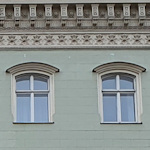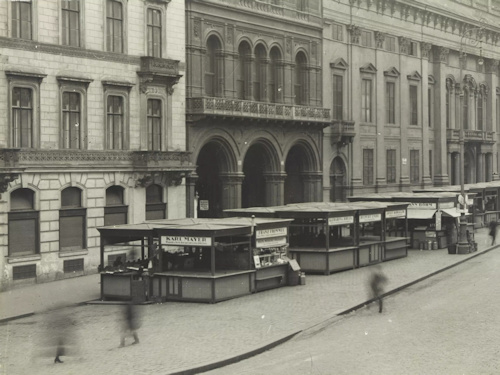
Various prestigious buildings surround the Freyung in Vienna’s old town. The very first house at Number 1, for example, was built by a count. Palais Hardegg dates back to 1847 and marks one entrance to the square.
- Early example of an aristocratic townhouse built for renting out as much as for the owner’s own pleasure
- Narrowly avoided modernisation in the early 20th century
- Notable for the pale green façade
- Book a themed guided tour* of Vienna
- See also:
Palais history

(An unusual colour for the area)
Back in the late middle ages, disparate buildings stood at this edge of the Freyung square; one belonged to Stift Admont (an abbey founded in 1074 and still located in the Austrian province of Styria).
Through the centuries, the buildings merged to leave two houses and finally, in the early 19th century, just one.
The prime site might have become a hotel but for the intervention of a Count Hardegg, who bought the plot and had the building we find there today constructed in 1847.
Architects Johann Romano and August Schwendenwein provided the design for the new palais (at the Freyung 1 address), whose owner continued the aristocratic associations of this part of the square; previous landowners included the Kaunitz, Metternich, and Colloredo-Man(n)sfeld families of nobles.
The architects worked on various palais buildings for commercial and private use in Vienna. These projects included Palais Metternich (now the Italian embassy) and notable locations around the Ring boulevard, such as Palais Schey (next to the Goethe monument).
Romano’s work for Hardegg even found mention in the announcement of the former’s passing in an April 1882 edition of the Neue Freie Presse paper.
Your typical count might have used the entire new building for his Vienna residence, but Hardegg seems to have been more entrepreneurial and somewhat ahead of his time. Although palais-like in appearance, the intention was always to rent out most of the premises to tenants.
In the early 1860s, for example, you could find adverts in newspapers for the “Levana” institute, which looked after children whose mental or physical condition prevented them from participating in conventional schooling.
And the “Union” society for traders and industrialists had their club facilities in Palais Hardegg in the late 1870s.

(A photo of the Freyung around 1925 with Palais Hardegg on the left and a market on the street outside; Wien Museum Inv.-Nr. 57962/3; excerpt reproduced with permission under the terms of the CC0 licence)
The family still seem to have used at least part of the palais for themselves. An 1890 report in the Wiener Salonblatt, for example, noted that (my translation):
Countess Lilian Hardegg, who was taken seriously ill with scarlet fever this year, has now returned to Vienna fully recuperated, and will spend the winter in Palais Hardegg.
And in case you were concerned for the poor Countess, she…
…recovered very quickly and is pleased at her most blooming countenance.
In its later years, the building fell into the hands of a bank or two, with plans (never implemented) to redesign the building and put in a large tower block on the corner.
The Albertina museum archives even have the preliminary sketches for the redesign (drawn up by Adolf Loos, one of the architectural mainstays of Viennese Modernism). Today’s occupants include offices of the Austrian Federal Ministry of Education, Science and Research.
The side facing the square with its notable green façade actually forms the narrow end of the entire palais, which includes two inner courtyards and stretches back along Strauchgasse all the way to Palais Ferstel (home to the famous Café Central).
How to get to Palais Hardegg
The Freyung square is part of the old town in Vienna, so reachable on foot if you’re strolling through the centre. Otherwise, look for the public transport travel tips over at the article for the Bank Austria Kunstforum Wien, a public art venue opposite Palais Hardegg.
(Unfortunately, the palais is not open to the public as such.)
Address: Freyung 1, 1010 Vienna